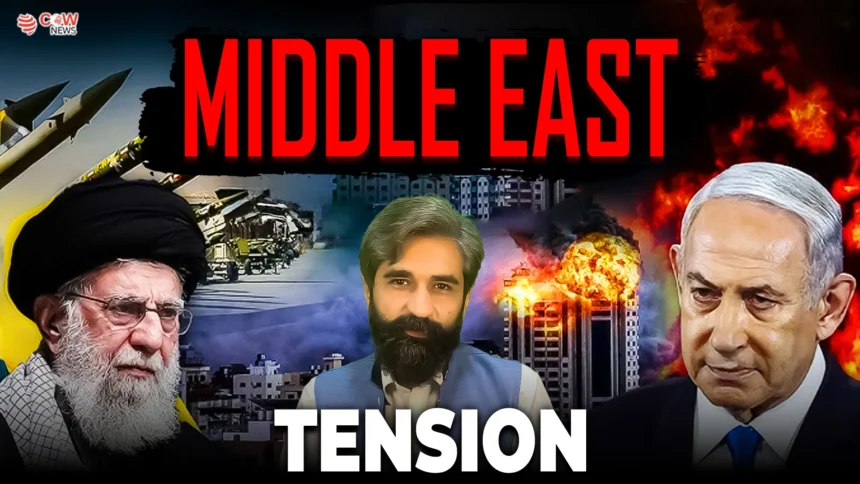By Faizan Hussain
Iran unfolds like an ancient carpet, each layer dyed by the ebb and flow of history—empire after empire, faith after faith—culminating today in a vibrant, complex nation. This multi-part exploration traces every twist of Iran’s journey. With 15,000 words planned, we’ll publish it in installments. This first installment covers Iran’s geography, the ancient Elamite civilization, the grandeur of the Achaemenids, and the social dynamics of those eras. Future chapters will follow in the same clear, flowing narrative.
Geography: Nature’s Fortress and Highway
Situated at the heart of Asia, Iran’s terrain is a mosaic of peaks and deserts. To the north, the snow-capped Alborz Mountains stand sentinel. In the south, the salty breezes of the Persian Gulf and the Gulf of Oman sweep inland. To the east lies the arid Lut Desert, while the lush slopes of the Zagros Mountains stretch across the west. This diverse geography has shaped Iran as both a natural fortress and a crossroads—inviting conquests, inspiring cultures, and breeding resilience.
Caravans of silk, spices, and ideas flowed through Iran for millennia—via branches of the Silk Road, maritime traders, and desert camel trains—planting the seeds of civilization. Thus, modern-day Iran remains a vibrant tapestry of Arabs, Turks, Kurds, Baluch, Lors, Gilaks, and more.
Imagine a spring morning 4,500 years ago, in southwestern Iran near the city of Susa. Along the Karkheh River valley, the Elamites built towering mud-brick temples, inscribed clay tablets, and thriving farms. They traded with Sumer, Akkad, and Babylon, mastered bronze craft, and worshipped the goddess Inshushinak.
Under King Untash-Napirisha, they raised the temple complex at Chogha Zanbil—one of the earliest known ziggurats. Their tablets reveal that Elamite women could buy land and inherit property, an uncommon right at the time. Despite repeated invasions from Mesopotamian powers, the Elamites preserved their language, script, and rituals—forming Iran’s first pillars of cultural resilience.
In the 6th century BCE, a Persian chieftain named Cyrus—later known as Cyrus the Great—united the Persian and Median tribes. He conquered Lydia, Babylon, and coastal Asia Minor, building an empire that stretched from the Indus River to the Aegean Sea, and from Central Asia to the Nile.
Cyrus’s famous “Cylinder of Human Rights” (now in the British Museum) reveals his tolerant mindset: temples were restored, slaves were freed, and conquered peoples were allowed to practice their own religions. His domain became a multicultural realm with Egyptians, Babylonians, Greeks, and Indus Valley subjects under one crown.
Darius I then built Persepolis, with its majestic marble terraces and richly carved reliefs. He introduced imperial roads and an efficient postal system that inspired later Greek, Roman, and Islamic administrations.
During this era, Zoroastrianism gained prominence. Centered on the worship of Ahura Mazda and the sacred flame, it emphasized the cosmic battle between truth and falsehood—ideas that infiltrated Persian ethics and royal rituals.
Society and Culture
While religious freedoms prevailed, the Achaemenid court was ceremonial. Petitioners waited in grand anterooms before approaching the king, bearing gifts of silverware, horses, textiles, or spices. Nowruz—celebrating spring—became a nine-day imperial tradition, marking harvest beginnings and uniting the empire.
Women of the royal household also held influence. Cyrus’s daughter Atossa played a political role, later marrying Darius I to secure dynastic legitimacy. Records mention queens, princesses, and princess–princes in administrative and economic contexts—signs of relative gender equality.
Clash of Civilizations: Greek Wars and Fall (492–330 BCE)
Darius I and Xerxes I challenged Greek city-states across the Aegean. The Marathon campaign, the naval confrontation at Salamis, and Plato’s Athens marked the great East–West clash. Both sides borrowed military tactics, architectural styles, and philosophical ideas from each other. Still, internal court intrigues, royal succession disputes, and persistent Greek resistance weakened the Achaemenids.
The empire fell at Gaugamela in 331 BCE, when Alexander the Great decisively defeated Darius III. A year later, Darius was murdered, ending Achaemenid rule and ushering in Hellenistic oversight.
Our story will continue with the rise of the Parthian and Sassanian empires, the final flicker of Zoroastrian fire, and the transformative Arab conquests. Stay tuned for the next installment, where we journey through Parthian and Sassanian eras—eras of renewal and revolution—before the arrival of Islam reshaped Iran forever.
In the 13th century, Iran faced one of the bloodiest invasions in world history. The Mongols, under Genghis Khan and later Hulagu Khan, tore through the region, reducing cities like Tehran, Nishapur, and Isfahan to rubble. Millions were killed, centuries of scholarship and culture were torched, and the Abbasid Caliphate in Baghdad was extinguished. Yet, in a remarkable twist of history, Iran did not vanish—it absorbed its conquerors. Over time, the Mongols themselves were assimilated into Iranian culture, adopting its language, religion, and administrative systems.
By the Safavid era, Iran had reemerged as a Shia stronghold—marking a decisive turn in its identity. This transformation brought it into frequent conflict with the Sunni Ottoman Empire. Though both empires claimed to rule in the name of Islam, their rivalry was marked by deep sectarian divides, political maneuvering, and the struggle for regional dominance. The Battle of Chaldiran in 1514 saw the Safavids suffer a major defeat, but tensions persisted, with repeated skirmishes over Iraq, Azerbaijan, and eastern Anatolia. These wars entrenched sectarian fault lines that still echo in the region today.
In the 19th century, Iran faced another series of debilitating conflicts—this time against the expanding Russian Empire. Under the weakened Qajar dynasty, Iran waged two wars to defend its claims over the Caucasus, but the superior Russian military and Iran’s internal instability led to the humiliating Treaties of Gulistan and Turkmenchay. As a result, Iran lost vast territories, including modern-day Azerbaijan, Armenia, and Dagestan.
Meanwhile, British influence began to grow—more through manipulation than direct warfare. Economic pressure, political intrigue, and support for internal uprisings allowed Britain to assert control over Iranian affairs. This interference culminated in the 1953 coup, when British and American intelligence agencies overthrew the democratically elected Prime Minister Mohammad Mossadegh after he nationalized Iran’s oil industry. It was a pivotal moment that still shapes Iranian mistrust of Western powers.
In the modern era, Iran’s most devastating war was fought not with an empire, but with its neighbor—Iraq. From 1980 to 1988, the Iran-Iraq War claimed over a million lives. The chaos following Iran’s 1979 Islamic Revolution, combined with Saddam Hussein’s ambition to dominate the region and control the Shatt al-Arab waterway, led to a brutal, drawn-out conflict. Though Iran survived and preserved its revolutionary government, the economic and human toll was staggering. The war, however, catalyzed a lasting shift: Iran became committed to building a self-sufficient defense apparatus—something that continues to define its strategic posture.
Today, Iran avoids direct confrontation and favors proxy warfare and regional influence. Its relationships with the United States, Israel, and Gulf Arab states remain deeply adversarial. Through groups like Hezbollah, the Houthis, and Iraq’s Popular Mobilization Forces, Iran projects power across the region. Events like the U.S. assassination of General Qassem Soleimani, Israeli cyberattacks, and international sanctions over its nuclear program reflect the ongoing, high-stakes tension.
Iran’s relationship with the Taliban has also fluctuated. After the 1998 killing of Iranian diplomats by the Taliban, Tehran adopted a hostile stance. But with the Taliban’s return to power in 2021, Iran recalibrated, engaging diplomatically to secure its eastern frontier and protect its interests.
From the ancient Achaemenids to the modern Islamic Republic, Iran’s history of warfare tells a consistent story: a nation bloodied, but never broken. Every defeat has forced Iran to reinvent itself—politically, militarily, and culturally. It remains, even today, a formidable regional actor rooted in resilience.
The question now is: where does Iran go from here?
As Israel’s ongoing war escalates, will Iran enter the fray directly—or continue to play the long game through its proxies? And more importantly, will the broader Islamic world rally behind Iran, or wait silently, hoping their turn never comes?







